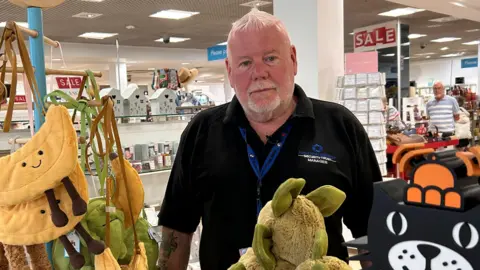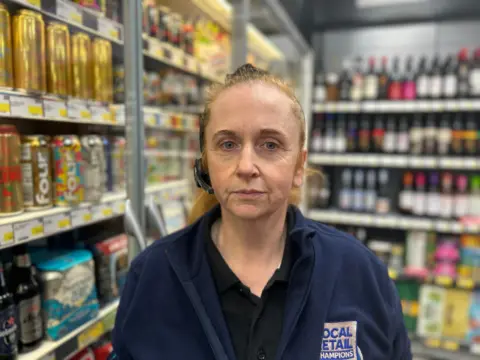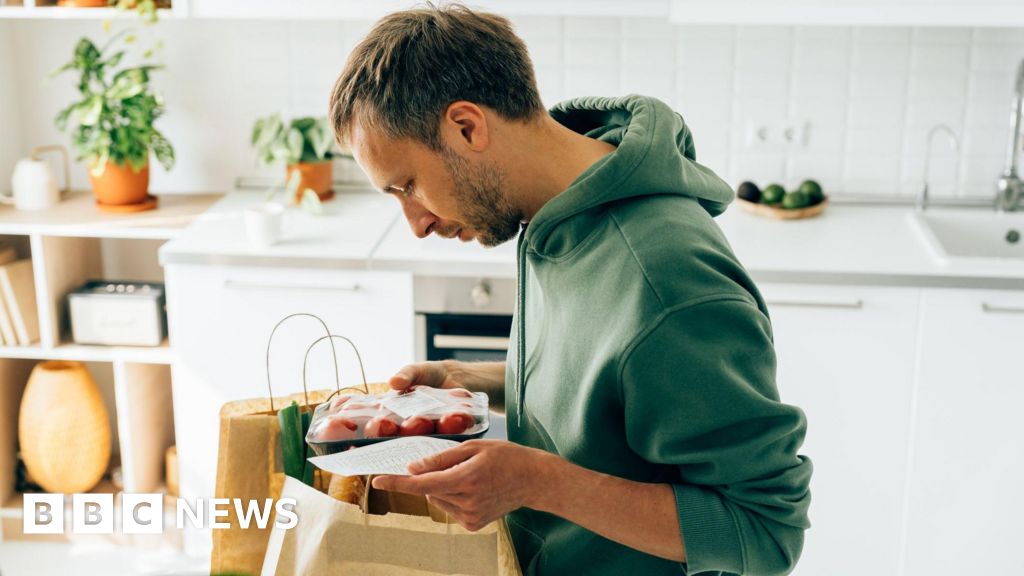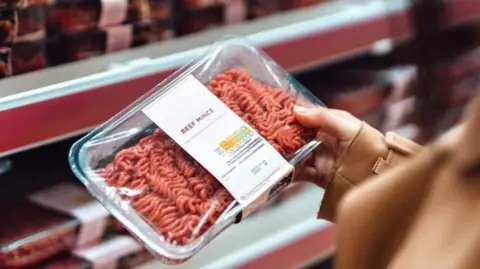Business
Jeep reveals Wrangler-inspired Recon EV, starting at $65,000

LOS ANGELES — Jeep’s new Recon all-electric SUV will start at $65,000, the American SUV brand announced Tuesday when it officially revealed the vehicle.
The 2026 Jeep Recon has been years in the making, as the idea of an electric vehicle inspired by the brand’s iconic off-road Wrangler SUV was first revealed in 2021. It is expected to begin production early next year at a plant in Mexico.
The Recon, revealed Tuesday ahead of the Los Angeles Auto Show, includes familiar, boxy Jeep styling as well as removable doors, a spare tire on the rear and open-air roof — all synonymous with the brand’s Wrangler SUV.
“With the Jeep Recon, we’re proving that electrification isn’t just compatible with off-road excellence, it can elevate it, delivering instant torque, precision control and a quieter, more connected driving experience that’s uniquely Jeep,” Bob Broderdorf, CEO of Jeep, said in a release.
The Recon is part of Jeep’s ongoing turnaround plan, which comes after years of sales declines and after several Jeep SUVs were canceled for the U.S. in an attempt to boost profits.
The EV is the last of four new or updated products Jeep promised to reveal in four months. The first three were a new Jeep Cherokee hybrid and redesigned versions of the Jeep Grand Cherokee and Grand Wagoneer.
“We’re wrapping up the 4×4 – four cars in four months. Recon is the last car to do that. That will complete the storyline,” Broderdorf said during a media call about the brand’s plans to launch a slew of special-edition vehicles next year.
The Recon’s electric motors combine to produce 650 horsepower and 620 foot-pounds of torque — similar to some V-6 and V-8 sports cars. But that power comes at a cost, with the vehicle getting up to 250 miles of range on a charge, which is lower than many current, less expensive EVs.
The Recon’s price is a roughly $14,000 premium over an entry-level 2025 Wrangler plug-in hybrid electric vehicle and a nearly $27,000 premium over a base 2026 Wrangler four-door. Pricing is in line with the $65,200 Wagoneer S EV, with a range of 294 miles.
The Recon comes as Jeep’s Stellantis parent company is heavily reducing its investments in EVs following changing market conditions and CEO shake-up in the past year. In the broader market, sales of EVs have plummeted following the end of up to $7,500 in federal incentives in September to purchase a plug-in electric vehicle.
Broderdorf said the end of federal incentives is expected to impact sales across the industry, including with the Recon, but the new SUV functions as an EV “bookend” alongside the sportier Wagoneer S for the Jeep brand’s electric portfolio.
“I’m not going to just chase volume just to chase volume,” he said during the media call. “I want to sell cars in the right way. Everybody who wants a [battery-electric vehicle], Recon, I want to make sure that we’re there for them. After that, it doesn’t really matter to me.”
The Recon is being produced at Stellantis’ Toluca Assembly Plant in Mexico alongside the Wagoneer S, Jeep Compass and the new Jeep Cherokee, which is being offered exclusively as a hybrid vehicle.
Broderdorf, who started leading the brand in February, said the plant can easily adjust to produce the higher-volume Compass and Cherokee depending on demand for EVs. Both gas-powered vehicles also are expected to be manufactured in the U.S. in the coming years for additional flexibility.
“”We’re going to grow, grow and grow,” Broderdorf previously told CNBC. “That’s the mission. And do it in a healthy way.”
Jeep’s been dealing with a spiraling sales decline that started after the brand reached an all-time high of more than 973,000 SUVs sold in 2018. The brand’s sales have fallen 40% since then to less than 590,000 units last year in the U.S.
Jeep’s sales through the third quarter of this year were up less than 0.5% compared with a year earlier. Jeep’s U.S. market share has fallen from 5.4% in 2019 to 3.7% since 2024, according to Cox Automotive.
Business
Time taken to bring shoplifters to justice is ‘unacceptable’, retailers tell BBC

Cherry Wilson and Jim ConnollyBBC News Investigations
 BBC
BBCThe time it takes to bring shoplifters to justice is “unacceptable” with retailers waiting longer for criminals to face punishment compared with a decade ago, the BBC has learned.
In one case, stores targeted by a thief waited up to 10 months for a shoplifter to be sentenced, despite retail workers piecing together her identity without help from the police.
Chelsea Strange, 33, went on a three-week crime spree stealing £2,000 worth of Jellycat soft toys from four different stores across the south west of England and one in Wales – which she later sold on Vinted.
Figures obtained by the BBC show the average time it takes for a shoplifting case to be dealt with from offence to completion in a magistrates’ court in England and Wales has risen by more than 80% in the last 10 years – from 32 days in 2014 to 59 days in 2024.
Trade bodies representing retailers have said many stores have been left frustrated with the way shoplifters are dealt with. They say the time taken reduces shopkeepers’ faith in the justice system – making them feel there’s no point in reporting crimes.
“The delays in bringing perpetrators to court really does add insult to injury,” said Andrew Goodacre, chief executive of the British Independent Retailers Association.
“It is no surprise many small shop owners simply do not bother reporting the crime in the first place. In their minds it makes no difference.”
The BBC has looked at a series of shoplifting cases which highlight how shops have been left waiting months for thieves to be brought to justice.
We followed the Jellycat shoplifting case since December 2024, when we reported how a garden centre owner in Bridport, Dorset, had managed to piece together the thief’s identity by scouring resale websites, deciphering her car’s personalised number plate, and finding her Facebook profile.
Austins department store in Newton Abbot, Devon, was also targeted by Strange on three separate occasions – and staff said they too were able to figure out who she was.
 Austins Department Store
Austins Department StoreHead of security Tom Hirst described the time taken to deal with shoplifters as “unacceptable” and said the criminal justice system is “too easy on them”.
“You’re better off shoplifting than going to work, that’s my honest view,” he added.
“Every time someone comes in and steals something, that cost gets passed on… it puts the price up so we’re all paying.”
In July, Strange, from Felton, Bristol, was sentenced to a 12-month community order at Newton Abbot Magistrates Court after admitting stealing from five shops across Devon, Somerset, Dorset and South Wales in September and October last year.
She was also ordered to pay nearly £1,800 in compensation.
Strange’s defence team said the offences were out of character and would not have taken place if it had not been for her poor mental health.

Fiona Malone, who runs a Post Office in Tenby, Pembrokeshire, also told the BBC she had to wait five months for a shoplifter who stole from her store to face sentencing – despite catching the thief red-handed.
The shopkeeper confronted Natalie Lintern after security cameras captured her stealing pre-mixed vodka cans, sandwiches and cake from the store in August last year.
Mrs Malone chased the 36-year-old down the street and got the stolen items back before reporting it to the police.
“The whole criminal justice system is too slow, it’s bureaucratic,” she told the BBC.
“We need to deal with these people and deal with them quickly and think about alternative punishments to stop them doing it in the first place.”
In January, Lintern, from Pembroke, Pembrokeshire, was given a 12-month community order after pleading guilty to stealing from Tenby Post Office and four other stores between April and September 2024.
But the sentence did not stop her from shoplifting again.
Six months later, she was back in court again where she admitted stealing from a service station in May.
She was given six weeks in jail, suspended for 12 months.
 Tenby Stores and Post Office
Tenby Stores and Post Office“What we’re doing as a society, it’s not working,” said Mrs Malone.
“It’s like whatever punishment she got it was almost like ‘Oh never mind I’ll just go out and do it again’.”
The most serious shop thefts can end up being heard at crown court where figures show the average time from the offence to cases being completed has increased from 111 days in 2016 to 128 days in 2024.
Shoplifter Bianca Mirica appeared in crown court after stealing more than £105,000 worth of goods from high street chain Boots between December 2023 and May 2024.
The 20-year-old, from Tottenham, London, was part of a shoplifting gang and would clear shelves of cosmetics and perfumes while another member of her team acted as look-out, according to police.
It took 14 months from her last theft before she was sentenced to 32 months in a young offenders’ institution, after pleading guilty to 18 charges of theft.
 Met Police
Met PoliceShoplifting has increased by 13% in the last year with 529,994 shoplifting offences recorded by police in England and Wales up to June 2025, according to the Office for National Statistics (ONS).
However, the ONS said there are signs that increasing rates of shops thefts being reported are now slowing.
The crime adds an estimated £133 onto the cost of an average UK household’s shopping bill each year, according to the Centre for Retail Research.
The government told the BBC it understood the “devastating impact” of shop theft on retailers and it was clear many cases were taking too long to be resolved, adding: “Justice delayed is justice denied.”
It said it is backing the courts with record funding and considering recommendations for long term structural reform of the system.
The National Police Chiefs Council said it had strengthened its relationship with retailers and improved information sharing in the last two years – which had resulted in a number of offenders being brought to justice.
Assistant Chief Constable Alex Goss said it planned to bring together police, shops and the security industry to make best use of their resources and “turn the tide on the volume of offending blighting our communities”.
Business
Good for mortgages, bad for food prices – how inflation dip affects you

Kevin PeacheyCost of living correspondent
 Getty Images
Getty ImagesWalking around your local supermarket and you’ll struggle to find much that’s healthy for your finances on the shelves – food price rises are accelerating.
The cost of the weekly shop is, and will continue to be, a worry for millions of people.
Beyond just food, prices of goods and services in general are going up, but the rate of those price rises have slowed.
And that is likely to bring better news for the cost of borrowing, in particular mortgage rates for homeowners and first-time buyers.
Are prices going up or down?
Prices pretty much always rise. Official statistics chart the movement in the cost of hundreds of goods and services in the UK.
It is the rate of increase that is crucial, and that inflation rate is published every month by the Office for National Statistics (ONS).
On Wednesday, the ONS said the rate of inflation had fallen to 3.6%, which means prices are rising more slowly than they were and will foster hope that inflation has peaked.

Delve a little further into the data, and there are more details about what is behind the latest trends.
For example, fish, vegetables, chocolate and confectionary were among the products that rose in price, although fruit prices fell slightly.
Recent research by the Bank of England found that people on average are still buying the same amount of food, but paying more for it. That said, they are changing the way they shop.
“Concerns about rising food costs and utility bills still dominate conversations,” it said.
“Households continue to change their shopping habits to reduce spending, such as buying more vegetables and reducing meat consumption.”
 Getty Images
Getty Images“Staples like bread, meat and potatoes all cost more than they did even a month ago,” says Danni Hewson, head of financial analysis at investment platform AJ Bell.
But she does point to a silver lining – the dip in the inflation rate means the Bank of England is now more likely to cut interest rates in December.
The Bank uses its benchmark interest rate – which heavily influences the cost of borrowing for households and businesses – to try to bring inflation to its target rate of 2%.
“Inflation remains well above the Band of England’s happy place of 2%,” says Alice Haine, personal finance analyst at Bestinvest.
But, she says, the latest figures could pave the way for a sixth interest rate cut since August last year.
The prospect of an interest rate cut has seen lenders make changes already. In recent weeks, many major lenders have lowered their rates for people getting a new fixed-rate mortgage or renewing their current one.
“There has been particular emphasis placed on rates for home movers with some of the best rates available for purchases,” says David Hollingworth, of mortgage brokers L&C.
Data from the financial information service Moneyfacts shows that the average rate on a new two-year fixed deal has fallen to 4.88%, and is down to 4.93% for the average five-year fixed deal.
Average rates for those only able to put down a deposit of 5% or 10% – often first-time buyers – are now looking lower than they have been at any time in the last two or three years.
Why are lenders cutting rates now?
Inflation is only one factor in lenders’ decisions to cut mortgage rates now.
Generally, Christmas is a quiet time for the housing market as potential buyers and sellers concentrate on turkey and trimmings instead.
So, they may be lowering rates in a bid to stimulate custom.
The same cannot be said for savings rates. “Competition has been scarce,” says Caitlyn Eastell, from Moneyfacts.
That is compounded by the fact that many of those buyers, sellers and savers have put plans on hold until they find out what happens in the Budget delivered by Chancellor Rachel Reeves on 26 November.
The Budget looms large over the housing market, with talk of taxation on high value properties, as well as over economic activity in general.
Reeves wants to introduce measures to lower the rate of inflation, and help people with the cost of living. However, she also needs to bring in more money or cut government spending to meet her own fiscal rules.
It is a delicate balancing act that will affect individual and family finances, affecting the money people have to spend in the supermarket and the appetite they have to save, as well as buy or sell a home.
Business
Lowe’s beats on quarterly sales, but lowers full-year profit forecast amid economic uncertainty

In an aerial view, a customer enters a Lowe’s store on May 21, 2025 in Cotati, California.
Justin Sullivan | Getty Images
Lowe’s on Wednesday posted a year over year sales increase for the quarter, but the company lowered its full-year profit outlook slightly to reflect a tougher economic backdrop.
The home improvement retailer now expects full-year total sales to be $86 billion, up from its previous expectations of $84.5 to $85.5 billion, because of a recent acquisition. However, it said it expects comparable sales, an industry metric that takes out one-time factors, to be flat compared to a year ago compared with the prior range it had shared of flat to up 1%.
For the full year, it now expects adjusted earnings per share of approximately $12.25, on the lower side of its previous range of $12.20 to $12.45.
In a news release, the company said it revised its outlook to “reflect the ongoing uncertainty in the macroeconomic environment” and the acquisition of Foundation Building Materials, which closed last month.
Here’s what the retailer reported for the fiscal third quarter compared with Wall Street’s estimates, according to a survey of analysts by LSEG:
- Earnings per share: $3.06 adjusted vs. $2.97 expected
- Revenue: $20.81 billion vs. $20.82 billion expected
Shares rose more than 5% in premarket trading on Wednesday after Lowe’s said its current quarter was off to a good start.
Lowe’s CEO Marvin Ellison said in the news release that the retailer posted positive comparable sales in the third quarter and also started the current quarter with positive comparable sales, “despite headwinds related to hurricane activity in the prior year.”
Lowe’s comparable sales rose 0.4% in the fiscal third quarter.
Home improvement trends, however, remain challenged by a slower housing market and higher borrowing costs — dynamics that have challenged the sector for more than two years.
In the three-month period ended Oct. 31, Lowe’s net income fell to $1.62 billion, or $2.88 per share, compared with $1.7 billion, or $2.99 in the year-ago period. Revenue increased from $20.17 billion in the year-ago quarter. Adjusting for one time items, including pre-tax expenses associated with its acquisitions, Lowe’s reported earnings of $3.06 per share.
Rival Home Depot on Tuesday also lowered its full-year profit forecast after missing Wall Street’s quarterly earnings expectations for the third quarter in a row. Chief Financial Officer Richard McPhail attributed weaker earnings to lower-than-usual storm activity, a tough housing market and consumer uncertainty.
Like Home Depot, Lowe’s has tried to attract more business from contractors and other home professionals to offset weaker do-it-yourself sales. In August, Lowe’s announced it had struck a deal to acquire Foundation Building Materials, a distributor of drywall, insulation and other interior building products for large residential and commercial professionals, for about $8.8 billion.
Earlier this year, Lowe’s announced another pro-focused acquisition. It said in April it had agreed to buy Artisan Design Group, which provides design services and installation of flooring, cabinets and countertops for homebuilders and property managers, for nearly $1.33 billion.
On the company’s earnings call in August, Lowe’s CFO Brandon Sink said he expected the company’s own strategy, not an improving industry backdrop, to drive sales for the year. He said the retailer expects “a roughly flat home improvement market” for the year.
-

 Tech1 week ago
Tech1 week agoFrom waste to asset: Turning ethanol production CO₂ into jet fuel
-

 Tech4 days ago
Tech4 days agoNew carbon capture method uses water and pressure to remove CO₂ from emissions at half current costs
-

 Politics5 days ago
Politics5 days agoBritish-Pakistani honoured for transforming UK halal meat industry
-

 Sports4 days ago
Sports4 days agoTexas A&M officer scolds South Carolina wide receiver after touchdown; department speaks out
-

 Business4 days ago
Business4 days agoThese 9 Common Money Mistakes Are Eating Your Income
-

 Business5 days ago
Business5 days agoWhat’s behind Rachel Reeves’s hokey cokey on income tax rises?
-

 Fashion6 days ago
Fashion6 days agoAdidas & Patrick Mahomes expand NIL programme with Texas Tech athletes
-

 Politics6 days ago
Politics6 days agoInternet freedom declines in US, Germany amid growing online restrictions











